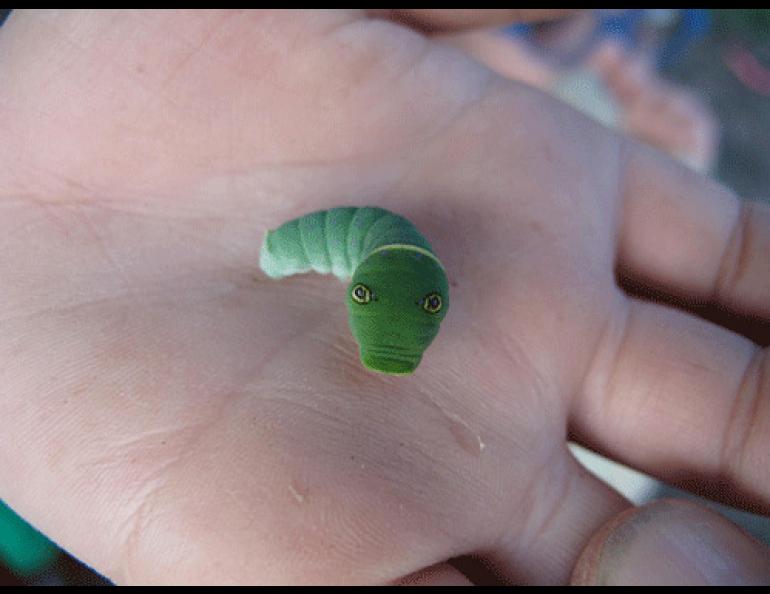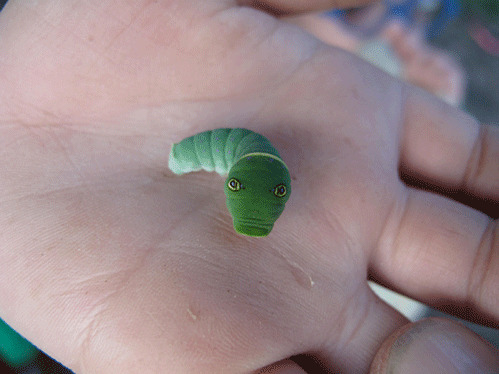
Is that caterpillar looking at me?
On a recent expedition to Alaska’s Quartz Lake, four-year-old visitor to Alaska Garrett Ast plucked a caterpillar from a twig. As Garrett held it in his palm, the caterpillar reared up and — with two sparkling baby blues — looked him right in the eye. Upon closer inspection, my nephew saw that, though striking; the caterpillar’s eyes weren’t real.
So was born the question of why a caterpillar might invest energy in producing a set of fake eyes. A little investigation led to a science research paper with one of the best examples of a first paragraph in its genre:
“You are a 12-gram, insectivorous, tropical rainforest bird, foraging in shady, tangled, dappled, rustling foliage where edible caterpillars and other insects are likely to shelter. You want to live 10-20 years. You are peering under leaves, poking into rolled ones, searching around stems, exploring bark crevices and other insect hiding places. Abruptly an eye appears, 1-5 centimeters from your bill. … If you pause a millisecond to ask whether that eye belongs to acceptable prey or to a predator, you are likely to be — and it takes only once — someone’s breakfast. Your innate reaction to the eye must be instant flight.”
John Burns of the Smithsonian Institution helped craft that sentence as one of three authors of “A tropical horde of counterfeit predator eyes,” which appeared this summer in Proceedings of the National Academy of Sciences.
Burns and his coauthors posted excellent photos of more than two-dozen tropical
caterpillars with elaborate false eyes. The caterpillars probably evolved those false eyes to mimic snakes, lizards, small mammals and other things that eat little birds.
But wait a second; there are no snakes or lizards in Alaska. Why would an Alaska caterpillar with aspirations of turning into a swallowtail butterfly pose as a reptile? I sent the photo to Burns, and to Derek Sikes, curator of entomology at the University of Alaska Museum of the North.
“Birds learn about snakes when they migrate (to the tropics and other places warm enough for snakes), so the snakes don’t have to be here for the mimicry to work. Nice, eh?” Sikes wrote in an e-mail.
Burns said even the rugged birds that don’t flee Alaska for the winter might have the image of a snake wired deep within their tiny brains, even though they will never see one.
“Despite the lack of snakes in Alaska, a small insectivorous bird might still be genetically programmed to retreat when abruptly confronted at close range by the caterpillar’s ‘eyes,’ owing to the bird’s evolutionary ancestry,” Burns wrote. “A resident bird species (like a chickadee or redpoll) might have descended in the not-too-distant past from a species that
spends much of its life in a tropical environment where selection would directly
preserve such behavior.”
* * *
University of Alaska Fairbanks Research Forester Tom Malone sent me a message regarding the dryness of firewood, the subject of a recent column. He calculates that cords of dry aspen and birch weigh
1,000 pounds less than the same wood in wet or green condition. Aspen with 60 percent or greater moisture weighs about 3,870 pounds per cord, compared to 2,340 pounds when the same wood is dried to 20 percent or less moisture. A cord of wet birch weighs 4,500 pounds wet, compared to 3,420 pounds dry. A green cord of spruce weighs in at 3,060 pounds, compared to 2,520 pounds dry.
An average cord of mixed firewood produces about 20 million British thermal units, Malone figures, while the same wood in its green condition gives off just 9 million Btu. If your house needs 230 million Btu of firewood heat per year, you could satisfy that with either 10 cords of dry birch or 20 cords of wet birch. Those employing the latter option would have carried 27.9 extra tons into the house, in addition to paying for twice as much wood.





